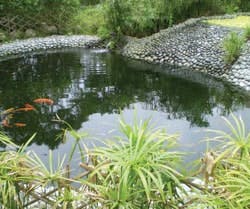Preserving & Reusing
Hong Kong’s first tertiary WWTP protects a nature preserve at a tourist landmark
Background
The Ngong Ping Wastewater Treatment Plant (WWTP) treats and reuses the wastewater generated in the Ngong Ping tourist area in Hong Kong, China, situated in the watershed for the Shek Pik Reservoir. This area is considered environmentally sensitive due to the water supply catchment and the country parks surrounding the Lantau plateau.
In order to protect the watershed water quality, the Ngong Ping WWTP utilizes the first tertiary treatment system in Hong Kong. The tributary collection system also collects storm water from the tourist areas and the wastewater from Ngong Ping village. In case of high storm water flows, there is an equalization tank on standby where Xylem-Flygt ejectors have been installed.
The treatment process generally consists of standby flow equalization, preliminary treatment, Xylem-Sanitare intermittent cycle extended aeration system (ICEAS) sequential batch reactors (SBRs), Xylem-Leopold dual media filters, ultraviolet (UV) disinfection and final chlorination. The treatment system reduces organic pollutants, suspended solids, nutrients and pathogenic organisms to very low levels.
To minimize the visual impact, a substantial portion of the facility is underground, with the above-ground buildings designed to match the architecture of the other tourist facilities. Due to its proximity to the tourist village, a gas scrubbing system treats odorous gases generated in the facility prior to discharge into the atmosphere.
The Treatment Process
An influent pump station with a coarse screen utilizes Xylem-Flygt submersible pumps to pump the influent to the main plant. Preliminary treatment consists of fine screening to remove large objects, vortex grit removal and dissolved air grease removal.
Secondary treatment utilizes an Xylem-Sanitaire ICEAS SBR. An SBR combines both the activated sludge processes of aeration and the clarification settling into one tank. The ICEAS process allows continuous flow to the units online. The process has three basic sequences: react, settle and decant. During the entire process, influent flow continues to enter the unit and is equally split between all units in operation.
Tertiary treatment uses the Xylem-Leopold FilterWorx dual-media filters for gravity, downflow particulate removal. The dual media consists of silica sand under anthracite coal. The media is placed on top of reverse graded support gravel and the Leopold Type S Universal dual parallel lateral underdrain. The anthracite acts as a roughing layer. The smaller-grain-size sand is the polishing layer removing the smaller particles. When the particles accumulate enough to increase headloss in the media, the filter is backwashed.
The final step is UV disinfection of bacteria and viruses. The disinfection of enteric pathogens occurs when certain wavelengths and a minimum strength of UV light change the chromosome structure of the microorganism, preventing reproduction. Since turbidity in the water will block the UV light, the water must be sufficiently cleaned by the upstream processes to ensure optimum disinfection. After minimal chlorination, the effluent water is stored in a storage tank prior to reuse.
Operations
The system has been in operation for more than two years. The operations staff has reported that effluent biochemical oxygen demand and total suspended solids are consistently less than 5 mg/L. All of the effluent water is currently reused. A portion of the effluent is applied to gardens and planted areas around the tourist area. The remainder is used for toilet flushing for the public restrooms.
